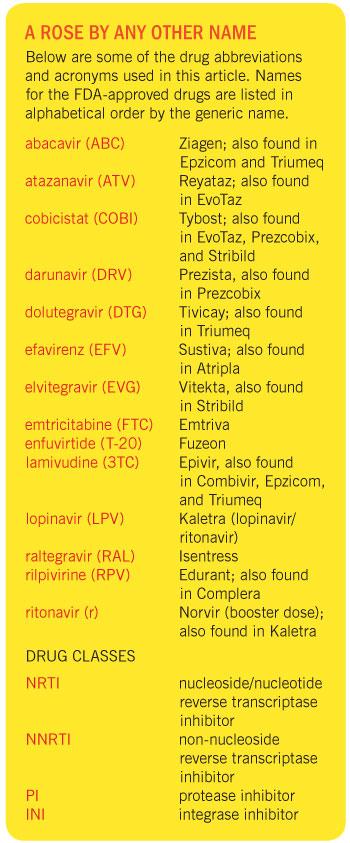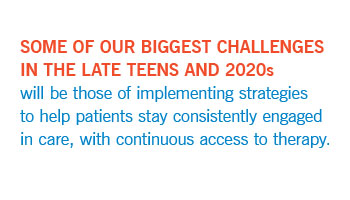

The decade of the 2020s will see the biggest change in HIV treatment paradigms since the birth of HAART two decades ago. Newer regimens will emphasize tolerability and adherence, without sacrificing potency, and long-acting injectables will debut. Yet while we contemplate the exciting new drugs that may emerge, there must be equal emphasis on how we deliver care. Even the most stunning advances in treatment will disappoint if we do not solve the harder challenges around care linkage, continuous care engagement, and uninterrupted access to ART for both prevention and therapy.
Antiretroviral therapy
Since March 1987, FDA has approved over 40 drugs for the treatment of HIV, including a few extended release formulations. Yet our armamentarium is less robust than the numbers suggest, as three are no longer marketed, and 11 are no longer recommended by guidelines from the Department of Health and Human Services (DHHS). Others have simply stepped aside as alternatives to more potent, forgiving, and tolerable therapies. As cross-resistance rapidly eliminates entire classes and limits treatment options, we still find ourselves at the end of the line all too quickly. Today’s pipeline however is robust, and licensure for its drugs will take us well into the Roaring ’20s.
An entire group of drugs likely to win FDA approval* over the next two to three years is the tenofovir alafenamide (TAF) family of fixed-dose compounds:
- elvitegravir/cobicistat/FTC/TAF (expected November 2015),
- FTC/TAF (expected 2016),
- rilpivirine/FTC/TAF (expected 2017), and
- darunavir/cobicistat/FTC/TAF (2016–17)
*Approval dates are based on educated guesses about when studies are projected to end, or on assumptions that could change.
These will cannibalize Stribild, Truvada, Complera, and Atripla, and provide the first single-tablet regimen (STR) containing a boosted protease inhibitor (PI). The tenofovir prodrug TAF concentrates in cells rather than plasma, causing less renal and bone toxicity compared to tenofovir DF (TDF; Viread), and may have an advantage in potency and resistance. The decrease in total and LDL cholesterol associated with TDF (Randell, 2010), however, appears to be lost with TAF.
Following TAF, NRTIs will be expected to have high potency, exceptionally low toxicity, daily or less frequent dosing potential, and high resistance barriers in order to play. Only time will tell whether EFdA, one of the few current NRTI candidates, will live up to its promise of potency and resistance advantage in the hands of Merck. If so, FDA approval might occur in the mid-20s.
The current NNRTI pipeline is thin, but Merck’s doravirine (MK-1439) is in Phase 3, having exhibited potency and low central nervous system (CNS) toxicity (Gatell, 2014) and could reach pharmacy shelves in 2017–18. On a similar course is fixed-dose doravirine/TDF/3TC, a compound that could potentially take advantage of generic 3TC (available now) and generic TDF (expected 2018).
Protease inhibitor development has slowed as companies have focused instead on incorporating cobicistat into FDCs, or fixed-dose combinations (EvoTaz, Prezcobix). TaiMed, though, is chasing the holy grail of a potent unboosted PI with TMB-607 (formerly from Ambrilla). This nanoformulation is active in the lab against PI resistance mutations and aims for monthly or quarterly dosing. This is the kind of innovation that will be required of future PIs. We may indeed see the boosted PIs find a new niche as tertiary therapy in the ’20s.
Integrase inhibitors (INIs) have stolen the spotlight lately, largely due to the high potency and tolerability and favorable resistance profile of dolutegravir, the first INI for daily dosing without a booster. Reformulated once-daily raltegravir is in trials and, if successful, headed toward possible approval in 2016. Of newer INIs in development, the most advanced is once-daily GS-9883, which also doesn’t require boosting. Now in Phase 2, successful trials could lead toward FDA approval by the end of the decade.
Earlier in development are the LEDGINs whose mechanism of action differs from the currently licensed strand transfer inhibitors, opening the possibility of combination INI strategies in the mid ’20s.
Long-acting meds
The promise of long-acting nanoformulation injectables for both treatment and prevention is the most riveting story to emerge in decades. Dolutegravir’s longer acting cousin, cabotegravir (GSK12657744, or 744, CAB), and long-acting rilpivirine are being studied together as monthly maintenance injections for treatment (and cabotegravir as a quarterly injection for PrEP). Meanwhile, an oral dolutegravir/rilpivirine co-formulation is planned for use as two-drug maintenance (as a switch for those who have achieved viral suppression on an initial three-drug regimen and have no history of viral resistance), based on LATTE results (Margolis, 2015). Oral cabotegravir will be developed as well, but used only as part of an initial regimen in persons who are transitioning to maintenance with injectable CAB/RPV.
If the nanos are safe and effective for maintenance, FDA approval could come by the turn of the decade. But success is not a slam-dunk. There are potential pitfalls to long-acting injectables such as the risk of incremental toxicity that cannot be halted by stopping drug, and resistance due to a long “pharmacologic tail” that could expose the virus to lengthy intervals of suboptimal dosing if repeated injections are not delivered on time. Barriers to safety monitoring and drug delivery must be identified and addressed, including exploration of new distribution systems such as designated pharmacy partners and home health options. Clearly, the 744/rilpivirine adventure is being closely watched by biopharmas itching to embrace nanotechnology and explore the acceptability of non-oral therapies.
Fusion inhibitors could get new life if albuvirtide, a better-looking cousin of enfuvirtide (T-20), can capitalize on its 11-day half-life, potentially allowing weekly dosing by injection. PRO-140, a monoclonal CCR5 antagonist (administered weekly or biweekly), and the monthly anti-CD4 monoclonal antibody TMB-360 (second generation ibalizumab) are moving (slowly) in clinical trials. The anti-HIV neutralizing antibody 3BNC117 showed promise in an early human trial. This new direction toward injectables could make the ’20s very interesting indeed.
Bristol-Myers Squibb (BMS) is attacking two new targets that could also change the treatment paradigm. An attachment inhibitor (AI), fostemsavir (BMS-663068), is in Phase 3, but only for highly treatment-experienced patients, as twice-daily dosing complicates use in initial therapy. Meanwhile, BMS-955176, a maturation inhibitor (MI), disrupts a late stage in viral replication and is entering Phase 2 for both treatment-naïve and experienced patients. If successful, FDA approval for the AI could come in late 2017–early 2018, and for the MI in 2020–21. Other AIs and MIs will surely emerge in the late teens and early ’20s and could provide options for treatment of multidrug-resistant virus as well as displace the NRTI class as first-line therapy.
Gene therapies, including the Sangamo zinc-finger nuclease approach, continue to make slow progress (Wang, 2015). While therapeutic vaccines have missed the sweet spot to date, newer vector-based gene immunotherapy raises hope of spanning the treatment and prevention realms (Gardner, 2010).
Finally, chronic inflammation contributes to excess non-AIDS morbidity and mortality in spite of viral suppression. Two potential approaches to controlling inflammation are in clinical trials, and this line of research is sure to expand in the next decade. Cenicriviroc blocks CCR2 and affects surrogate markers of inflammation, in addition to its CCR5-mediated antiviral effect. It is now under study for fatty liver (non-alcoholic hepatic steatosis; NASH). The NIH REPRIEVE trial will look at the impact of pitavastatin on cardiac outcomes over five years, with results in the ’20s (reprievetrial.org).

What about generics?
Generic ARVs have had little impact on overall treatment cost, as most drugs have been rendered obsolete prior to becoming generic. This is due to the rapid pace of HIV drug development combined with a 20-year patent life plus additional years of marketing protections (called “exclusivity”). Of the seven generic ARVs, only lamivudine (3TC) and abacavir are still recommended for use by DHHS and IAS-USA guidelines. Eclipsed by INIs, efavirenz and atazanavir are no longer recommended as first-line therapy, but they are due to become generic in 2017–18. By the time TDF becomes generic in 2018, it will be seen as the ugly stepmother of TAF, although it is likely to be incorporated into multiple generic formulations and continued to be used in prevention until TAF is further studied for use in PrEP.
It is through the coupling of generics in FDCs with branded drugs that a cost-benefit could first be realized. Lopinavir/ritonavir/lamivudine is approved in Europe and twice-daily raltegravir/lamivudine could be an incremental advance. ViiV Healthcare has the opportunity to pair generic abacavir/lamivudine with dolutegravir to bring down the high price of Triumeq. One study projects first-year cost savings nearing a billion dollars using a partially generic efavirenz-based regimen (Walensky, 2013).
Concerns about the potential adherence consequences of decoupling FDCs deserve study to ensure that outcomes are preserved while money is saved. The fear that insurance companies could mandate use of obsolete generics has not yet materialized, but this must be closely watched into the next decade as prior authorizations and drug tiering with high cost sharing are other ways to steer patients toward outdated generics and limit access to the best new drugs. There is likely to be increased attention to cost implications as incremental benefits influence the ranking of preferred therapies by guidelines. Some fear that inequality in standards of care could emerge as a trade-off for treating larger volumes of patients, mirroring the use of obsolete drugs in low-resource countries for the sake of cost. We will need to systematically evaluate treatment outcomes to assure that cost pressure does not compromise health.
Improving the Care Continuum
Inventing drugs is just the beginning. It is equally, if not more, challenging to reinvent our healthcare system to increase care access, provide better support for care linkage and retention, and improve services for mental health, substance use, housing assistance, incarceration transition, and other essential needs. The care continuum consistently shows our failings in care retention and viral suppression.
Some of our biggest challenges in the late teens and ’20s will be those of implementing strategies to help patients stay consistently engaged in care, with continuous access to therapy. One structural intervention, the Health Information Exchange (HIE), has proven effective in identifying persons who are out of HIV care as they seek non-HIV medical services at clinics and hospitals, and achieving high rates of reengagement in care (Herwehe, 2012). Building HIEs for HIV and other medical purposes should be a national priority over the next decade.
The Affordable Care Act has the potential to greatly improve the care of people with HIV, but early implementation has been hampered by lack of Medicaid expansion, especially in states with the highest HIV rates. Among the insured, drug affordability is compromised by plans that place HIV meds on unaffordable tiers in apparent violation of anti-discrimination provisions of the ACA. High cost sharing puts patients at risk for inconsistent drug access and viral resistance. Additionally, traditional insurance plans generally do not offer adequate coverage for mental health and substance use services, transportation, or case management to assist with housing and other critical social needs of people with HIV.
Ryan White programs have been called upon to supplement the ACA in providing access to these so-called “wrap-around” services, assistance with care engagement, and support for high out-of-pocket costs. Yet clinics in non-expansion states now are straining to care for newly diagnosed uninsured patients. Over time, without substantially increased funding, waiting lists will emerge both for clinical care and drug access through the AIDS Drug Assistance Program (ADAP). Medicaid expansion and preservation (perhaps re-invention) of Ryan White must be priorities in the coming decade.
Other priorities entail exploring novel options for care delivery, including telemedicine visits, use of non-traditional venues for delivery of injectables and PrEP, and judicious use of non-clinicians (especially pharmacists) to supplement the waning clinical workforce.
Finally, we must push for structural changes to better integrate prevention and care, as biomedical prevention through both treatment and PrEP stretches the boundaries of traditional systems. Federal funding streams across agencies (HRSA, CDC, SAMHSA) must be aggressively reevaluated and harmonized. And while each of the Bad Bugs (HIV, STIs, viral hepatitis, and TB) brings its own science and epidemiology to the table, and deserves to have separate attention and strategies, successful translation of science amid increasing economic constraints require us to eliminate artificial silos of funding that create duplicative infrastructures and waste. Program Coordination and Service Integration (PCSI) has been a CDC buzzword for a decade, yet not enough has been done at the federal level to make it a reality in the field.
The 2020s may be an exuberant time for treatment paradigms, and a roller-coaster time for treatment provision. Ever mindful of the progress we have made, we will be further challenged to extend those successes to the largest number of people possible. Time to get to work—the Roaring ’20s are on the way!
Dr. Melanie Thompson is Principal Investigator of the AIDS Research Consortium of Atlanta (ARCA) where she has conducted over 400 studies of HIV, STDs, and viral hepatitis. She is a member of the DHHS Panel on Antiretroviral Guidelines for Adults and Adolescents and provided the doctor’s comments for the Positively Aware 2015 HIV Drug Guide.


